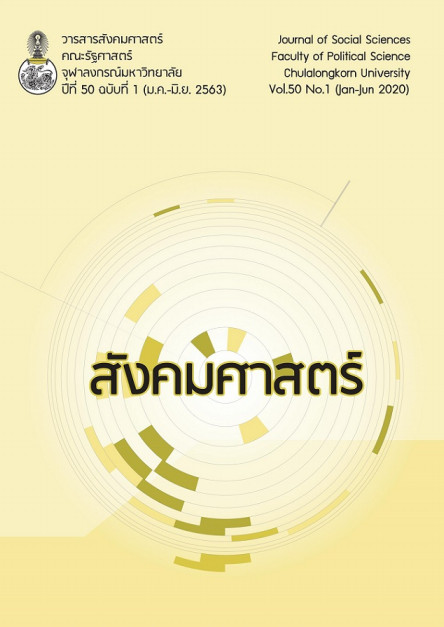ผลกระทบของการสอดส่องผ่านเทคโนโลยีและสื่อสังคมที่มีต่อครูและผู้ดูแลเด็กปฐมวัย
DOI:
https://doi.org/10.61462/cujss.v50i1.710คำสำคัญ:
เทคโนโลยี, สื่อสังคม, การสอดส่อง, ปฐมวัย, ครูบทคัดย่อ
การวิจัยเชิงคุณภาพด้วยวิธีการศึกษาแบบรายกรณีในครั้งนี้ มีวัตถุประสงค์เพื่อศึกษาบริบทการทำงานภายใต้การถูกสอดส่องจากเทคโนโลยีและสื่อสังคม ตลอดจนผลกระทบต่อครูและผู้ดูแลเด็กปฐมวัย โดยเก็บข้อมูลจากครูและผู้ดูแลเด็กปฐมวัยในเขตกรุงเทพมหานคร และจังหวัดเชียงใหม่ รวม 41 คน ด้วยวิธีการสุ่มตัวอย่างแบบเฉพาะเจาะจง โดยใช้วิธีการสัมภาษณ์แบบเจาะลึกร่วมกับการสังเกตการณ์แบบไม่มีส่วนร่วมในการเก็บรวบรวมข้อมูล ผลการศึกษาพบว่าครูและผู้ดูแลเด็กปฐมวัยต้องทำงานโดยถูกควบคุมผ่านทางเทคโนโลยีสื่อการเรียนการสอน เครื่องมือเพื่อควบคุมการปฏิบัติงาน เทคโนโลยีการสื่อสารผ่านทางแอปพลิเคชันในโทรศัพท์เคลื่อนที่แบบสมาร์ทโฟน และการสื่อสารผ่านสื่อสังคมออนไลน์ซึ่งทำให้ครูไม่สามารถแยกเวลางานออกจากเวลาส่วนตัว และต้องทำงานด้วยความรู้สึกระแวดระวัง อีกทั้งส่งผลกระทบทางอ้อมต่อเด็กในแง่ความปลอดภัย การละเมิดสิทธิ และถูกปิดกั้นประสบการณ์และโอกาสในการเรียนรู้ ตลอดจนทำให้เกิดความขัดแย้งและความไม่ไว้วางใจซึ่งกันและกันระหว่างครู โรงเรียน และผู้ปกครอง ดังนั้นจึงควรมีการสร้างกติกาในการใช้เทคโนโลยีและสื่อสังคมเหล่านี้ร่วมกัน
Downloads
เอกสารอ้างอิง
Allen, Anita LaFrance. 2000. “Gender and Privacy in Cyberspace.” Standford Law Review 52(5): 1175-1200.
Altheide, David L. 2004. “The Control Narrative of the Internet.” Symbolic Interaction 27(2): 223-245.
Ball, Kirstie. 2010. “Workplace Surveillance: An Overview.” Labor History 51(1): 87-106.
Drugli, May Britt, and Anne Mari Undheim. 2012. “Partnership between Parents and Caregivers of Young Children in Full-time Daycare.” Child Care in Practice 18(1): 51-65.
Green, Stephen. 1999. “A Plague on the Panopticon: Surveillance and Power in the Global Information Economy.” Information, Communication & Society 2(1): 26-44.
Jones, Peter. 1999. “Building the Empire of the Gaze: The Modern Movement and the Surveillance Society.” Architectural Theory Review 4(2): 1-14.
Kessiri Kamol and Chayapim Usaho. 2014. “Kan Wikhro Kan Borihan Rongrian Ekkachon Thi Mi Khwam Pen Loet Nai Prathet Thai Tam Ken Mattrathan Rangwan Khunnaphap Haeng Chat Malcolm Baldrige.” [An Analysis of the Educational Administration of Excellent Private Schools in Thailand Based on Malcolm Baldrige National Quality Award Criteria]. An Online Journal of Education 9(3): 84-97. (in Thai)
Kriengsak Sueluerm, Sirikul Isaranurug, Pranee Suthisukon, Dusanee Dammee, Jiraporn Chompikul, and Bang-On Thepthien. 2008. Botbat Khong Phudulae Dek Kap Kan Chat Rabop Borikan Phainai Sun Phatthana Dek Lek Khong Ongkon Pokkhrong Suanthongthin. [The Role of Child Caregivers in the Management of Day Care Center Services Provided by Local Government Organizations]. Journal of Public Health and Development 6(2): 39-48. (in Thai)
Marwick, Alice E. 2012. “The Public Domain: Social Surveillance in Everyday Life.” Surveillance & Society 9(4): 378-393.
Marx, Gary T. 2002. “What’s New about the ‘New Surveillance’? Classifying for Change and Continuity.” Surveillance & Society 1(1): 9-29.
Natchanan Charatcharungkiat, and Alisa Wacharasindhu. 2013. “Khunnaphap Chiwit Khong Phudulae Dek Thi Pen Rok Nai Klum Autistic Spectrum Lae Patchai Thi Kiaokhong.” [Quality of Life among Caregivers of Children with Autistic Spectrum Disorders and Associated Factors]. Journal of the Psychiatric Association of Thailand 58(3): 233-244. (in Thai)
National Research Council of Thailand. 2017. “Nayobai Lae Yutthasat Kan Wichai Khong Chat Chabap Thi 8 (Pho So 2555-2559).” [The Eighth National Research Policy and Strategy (2012-2016)]. Accessed September 28, 2017. http://www2.nrct.go. th/NewsSection/tabid/78/ctl/ArticleView/mid/388/articleId/515/--8--25552559. aspx#.W6x7BNczbMx. (in Thai)
O'Brien, Mark. 2008. “Law, Privacy and Information Technology: A Sleepwalk Through the Surveillance Society?” Information & Communications Technology Law 17(1): 25-35.
Page, Damien. 2017. “Conceptualising the Surveillance of Teachers.” British Journal of Sociology of Education 38(7): 991-1006.
Powell, Sacha, and Kathy Goouch. 2012. “Whose Hand Rocks the Cradle? Parallel Discourses in the Baby Room.” Early Years: An International Research Journal 32(2): 113-127.
Pramote Prasartkul, and Patama Vapattanawong. 2011. “Chut Plian Prachakon Nai Prathet Thai.” [Transitional Point of the Thai Population]. In Prachakon Lae Sangkhom 2554 Chut Plian Prachakon Chut Plian Sangkhom Thai. [Population and Society 2011 Thailand Population in Transition: A Turning Point for Thai Society], edited by Sureeporn Punpuing and Malee Sunpuwan, 13-22. Nakhon Pathom: Institute for Population and Social Research. (in Thai)
Thailand. Ministry of Education. Office of the Education Council. 2013. Botbat Khong Phomae Khru Philiang Lae Phudulae Dek Nai Kan Liangdu Lae Phatthana Dek Pathommawai. [Role of Parents, Teachers and Caregivers in Taking Care of Primary School Children and Child Development]. Bangkok: Office of the Education Council, Ministry of Education. (in Thai)
Thailand. Ministry of Information and Communication Technology. National Statistical Office. 2014. “Chamnuan Prachakon Ayu 15 Pi Khuen Pai Chamnaek Tam Sathanaphap Raengngan Lae Phet Pho So 2550-2559.” [Number of Population Aged over 15 Years Classified by Labor Status and Sex (2007-2016)]. Accessed March 30, 2017. http://service.nso.go.th/nso/web/ statseries/statseries03.html. (in Thai)
United Nations Population Fund Country Office in Thailand. 2011. Phonkrathop Khong Kan Plianplaeng Thang Prachakon Nai Prathet Thai. [Impact of Population Changes in Thailand]. Bangkok: UNFPA Thailand. (in Thai)
Wood, David Murakami, and C. William R. Webster. 2009. “Living in Surveillance Societies: The Normalization of Surveillance in Europe and the Threat of Britain’s Bad Example.” Journal of Contemporary European Research 5(2): 259-273.
ดาวน์โหลด
เผยแพร่แล้ว
รูปแบบการอ้างอิง
ฉบับ
ประเภทบทความ
สัญญาอนุญาต
ลิขสิทธิ์ (c) 2020 คณะรัฐศาสตร์ จุฬาลงกรณ์มหาวิทยาลัย

อนุญาตภายใต้เงื่อนไข Creative Commons Attribution-NonCommercial-NoDerivatives 4.0 International License.
เงื่อนไขการอนุญาตสาธารณะ
นโยบายลิขสิทธิ์และการอนุญาต
วารสารสังคมศาสตร์ จุฬาลงกรณ์มหาวิทยาลัย เผยแพร่เนื้อหาทั้งหมดภายใต้ สัญญาอนุญาตครีเอทีฟคอมมอนส์แบบแสดงที่มา-ไม่ใช้เพื่อการค้า-ไม่ดัดแปลง 4.0 นานาชาติ (CC BY-NC-ND 4.0)
ลิขสิทธิ์
บทความทั้งหมดที่ตีพิมพ์ในวารสารสังคมศาสตร์ จุฬาลงกรณ์มหาวิทยาลัย เป็นลิขสิทธิ์ของ คณะรัฐศาสตร์ จุฬาลงกรณ์มหาวิทยาลัย ผู้เขียนจะโอนสิทธิ์ทั้งหมดให้แก่วารสารเมื่อบทความได้รับการตอบรับให้ตีพิมพ์
สัญญาอนุญาต CC BY-NC-ND 4.0
ภายใต้สัญญาอนุญาตนี้:
-
แสดงที่มา (BY): ผู้ใช้ต้องแสดงที่มาโดยอ้างอิงถึงผู้เขียน คณะรัฐศาสตร์ จุฬาลงกรณ์มหาวิทยาลัย และวารสารสังคมศาสตร์ จุฬาลงกรณ์มหาวิทยาลัย พร้อมทั้งให้ลิงก์ไปยังสัญญาอนุญาต และระบุหากมีการเปลี่ยนแปลง ทั้งนี้สามารถทำได้ในลักษณะที่สมเหตุสมผล แต่ต้องไม่ทำในลักษณะที่แสดงว่าผู้อนุญาตให้การรับรองผู้ใช้หรือการใช้งานดังกล่าว
-
ไม่ใช้เพื่อการค้า (NC): ผู้ใช้ไม่สามารถใช้เนื้อหาเพื่อวัตถุประสงค์ทางการค้า การใช้งานเชิงพาณิชย์จะต้องได้รับอนุญาตเป็นลายลักษณ์อักษรล่วงหน้าจากผู้เขียนและคณะรัฐศาสตร์ จุฬาลงกรณ์มหาวิทยาลัย
-
ไม่ดัดแปลง (ND): หากผู้ใช้นำเนื้อหาไปรวม ดัดแปลง หรือต่อยอด ผู้ใช้ไม่สามารถเผยแพร่งานที่ดัดแปลงนั้นได้ การดัดแปลงผลงานจะต้องได้รับอนุญาตเป็นลายลักษณ์อักษรล่วงหน้าจากผู้เขียนและคณะรัฐศาสตร์ จุฬาลงกรณ์มหาวิทยาลัย
นโยบายการเข้าถึงแบบเปิด
วารสารสังคมศาสตร์ จุฬาลงกรณ์มหาวิทยาลัย ให้การเข้าถึงเนื้อหาแบบเปิดโดยทันทีตามหลักการที่ว่าการทำให้งานวิจัยสามารถเข้าถึงได้อย่างเสรีแก่สาธารณะจะสนับสนุนการแลกเปลี่ยนความรู้ในระดับโลก ผู้ใช้สามารถอ่าน ดาวน์โหลด คัดลอก เผยแพร่ พิมพ์ ค้นหา หรือเชื่อมโยงไปยังเนื้อหาฉบับเต็มของบทความได้โดยไม่ต้องขออนุญาตล่วงหน้าจากผู้จัดพิมพ์หรือผู้เขียน ทั้งนี้เป็นไปตามสัญญาอนุญาต CC BY-NC-ND 4.0
นโยบายการเก็บบันทึกด้วยตนเอง
ผู้เขียนสามารถเก็บบันทึกบทความฉบับตีพิมพ์สุดท้าย ต้นฉบับที่ส่ง (preprint) หรือฉบับที่ผ่านการประเมิน (postprint) ในคลังสถาบันหรือเว็บไซต์ส่วนตัวได้ โดยต้องมีการอ้างอิงการตีพิมพ์ครั้งแรกในวารสารสังคมศาสตร์ จุฬาลงกรณ์มหาวิทยาลัย พร้อมระบุแหล่งอ้างอิงที่สมบูรณ์และลิงก์ไปยังเว็บไซต์ของวารสาร
การขออนุญาต
สำหรับการใช้งานนอกเหนือจากที่ครอบคลุมโดยสัญญาอนุญาต CC BY-NC-ND 4.0 กรุณาติดต่อ:
กองบรรณาธิการ
วารสารสังคมศาสตร์ จุฬาลงกรณ์มหาวิทยาลัย
คณะรัฐศาสตร์ จุฬาลงกรณ์มหาวิทยาลัย
Email: cusocscij@gmail.com
สำหรับข้อมูลเพิ่มเติมเกี่ยวกับสัญญาอนุญาตครีเอทีฟคอมมอนส์แบบแสดงที่มา-ไม่ใช้เพื่อการค้า-ไม่ดัดแปลง 4.0 นานาชาติ กรุณาเยี่ยมชม: https://creativecommons.org/licenses/by-nc-nd/4.0/deed.th





